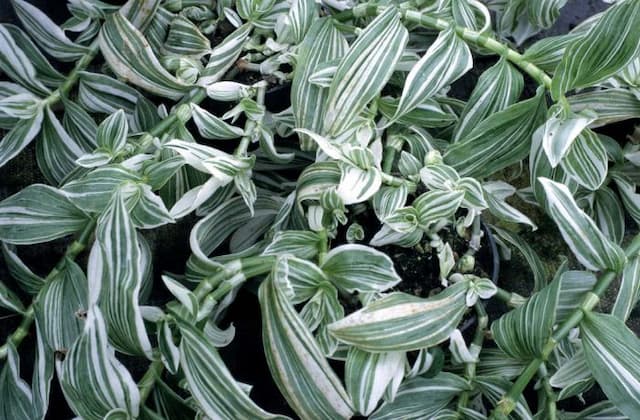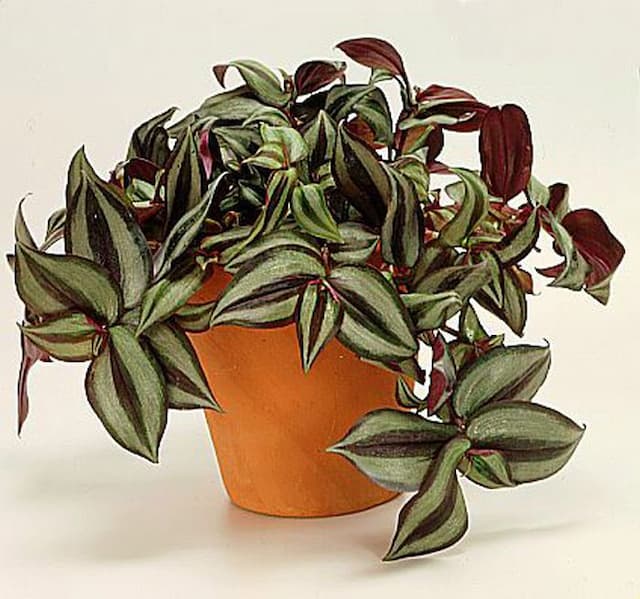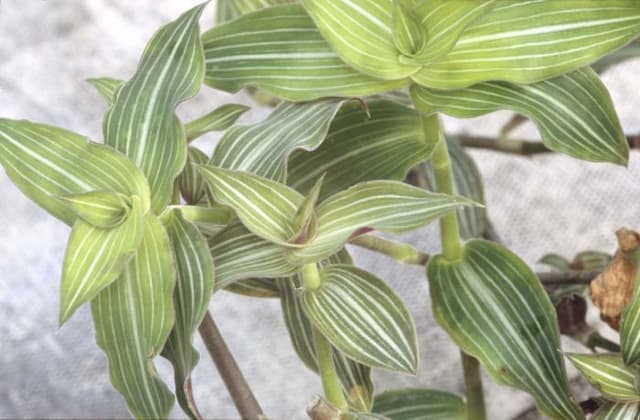Somali kitten ears Cyanotis somaliensis

ABOUT
Cyanotis somaliensis, commonly known as pussy ears, is noted for its unique and attractive foliage. The leaves of this plant are fleshy and velvety, covered in fine hairs that give them a soft, almost furry texture. Despite its plushy leaf surface, the color can be described as a vibrant green, adding to its eye-catching nature. The leaves grow in a rosette pattern, radiating outwards in a circular fashion from the plant's central stem. They are spear-shaped, tapering to a point at the tip, and the leaf edges sometimes exhibit a subtle scalloping. What adds to the plant's charm is the fact that the underside of the leaves occasionally display a purplish hue, providing a beautiful contrast with the green topside. As the plant matures, it can sometimes produce small, star-shaped flowers. These blooms are often a pale blue to lilac in color, adding a delicate touch of color when in season. The appearance of these flowers provides a delightful contrast to the furry foliage, making pussy ears a unique and ornamental choice for plant enthusiasts.
About this plant
 Names
NamesFamily
Commelinaceae.
Synonyms
Somali Cat Ears, Pussy Ears, Furry Kittens.
Common names
Cyanotis somalensis.
 Toxicity
ToxicityTo humans
The Cyanotis somaliensis, commonly known as the Pussy Ears, is not known to be toxic to humans. There are no widely reported cases of poisoning from ingesting this plant, and it is generally considered non-toxic. However, it is always advisable to avoid ingesting any houseplants and to keep them out of reach of small children who might chew on them.
To pets
For pets, the Cyanotis somaliensis, also known as the Pussy Ears, is generally considered non-toxic as well. It is not typically associated with poisoning in pets like cats or dogs. However, if pets consume a large amount of any non-food plant, they may experience mild gastrointestinal upset such as vomiting or diarrhea. As with humans, it is a good practice to keep houseplants out of reach of pets, particularly those prone to chewing on plants.
 Characteristics
CharacteristicsLife cycle
Perennials
Foliage type
Evergreen
Color of leaves
Green
Flower color
Blue
Height
1 feet (0.3 meters)
Spread
1 feet (0.3 meters)
Plant type
Herb
Hardiness zones
10
Native area
Somalia
Benefits
 General Benefits
General Benefits- Low Maintenance: Cyanotis somaliensis, commonly known as the Somali Cat's Ear, is a hardy plant that requires minimal care, making it ideal for busy or novice gardeners.
- Drought Tolerance: This plant is highly tolerant of drought conditions, which makes it suitable for arid climates and water-wise gardens.
- Aesthetic Appeal: With its fuzzy, cat ear-shaped leaves, the Somali Cat's Ear adds a unique and attractive texture to plant displays and indoor arrangements.
- Growth Habit: It spreads gradually, allowing it to fill spaces in terrariums or rock gardens without becoming invasive, providing a natural carpeting effect.
- Pet Safety: The Somali Cat's Ear is non-toxic, making it safe to grow in homes with pets.
- Propagation Ease: The plant can be easily propagated from stem cuttings, which allows for easy sharing and multiplication of the collection.
 Medical Properties
Medical PropertiesThis plant is not used for medical purposes.
 Air-purifying Qualities
Air-purifying QualitiesThis plant is not specifically known for air purifying qualities.
 Other Uses
Other Uses- Cats generally enjoy the leaves of the Pussy Ears plant, which can be used to provide a small amount of entertainment or distraction for indoor felines.
- Pussy Ears, with its furry leaves, can be used in tactile sensory gardens, providing a unique texture for visitors to touch and feel.
- It can be used in miniature gardens or fairy gardens due to its small size and interesting foliage, adding a touch of the exotic.
- Pussy Ears plant can be utilized in educational settings to illustrate plant adaptation, especially the way it has adapted to retain moisture in arid conditions.
- In creative crafts, the leaves can be incorporated into floral arrangements to provide contrast and a unique velvety texture.
- The plant can be a subject for botanical illustration or photography, especially suited for close-ups that highlight the intricate details of its leaves.
- Pussy Ears can be grown as part of a living green gift instead of traditional flower bouquets, offering a more lasting and sustainable option.
- The plant's ability to propagate easily from cuttings can serve as an educational tool for propagation techniques in gardening workshops.
- As an ornamental plant, Pussy Ears can enhance the visual appeal of terrariums, especially when paired with rocks and other succulents.
- Pussy Ears can be used as a natural indicator for over-watering in a mixed planting arrangement, as its leaves will tend to wilt or rot when too much moisture is present.
Interesting Facts
 Feng Shui
Feng ShuiThe Pussy Ears is not used in Feng Shui practice.
 Zodiac Sign Compitability
Zodiac Sign CompitabilityThe Pussy Ears is not used in astrology practice.
 Plant Symbolism
Plant Symbolism- Resilience: As a succulent, the Pussy Ears (Cyanotis somaliensis) often symbolizes the ability to withstand tough conditions and bounce back from adversity due to its thick, fleshy leaves that retain water.
- Adaptability: This plant can thrive in a variety of environments, making it a symbol of adaptability and versatility.
- Vitality: With its vigorous growth and hearty nature, Pussy Ears represent vitality and the energy of life.
- Independence: The plant's low maintenance requirements make it a symbol of independence and self-sufficiency.
- Charm and Attraction: The furry leaves of the Pussy Ears can symbolize a unique charm and the allure of the uncommon, drawing interest and attention.
 Water
WaterThe common name for Cyanotis somaliensis is Pussy Ears. This succulent-type plant should be watered thoroughly, but only when the top inch of soil feels dry to the touch, to prevent root rot. Generally, watering once a week during the growing season is sufficient. During winter, reduce watering to every other week or less, depending on the plant's environment. Each watering should be done with enough water to saturate the soil, which might be about 8-16 ounces for smaller pots, but avoid leaving standing water in the pot's saucer.
 Light
LightPussy Ears prefer bright, indirect sunlight but can tolerate some direct morning sun. An east-facing window is an ideal spot for this plant to ensure it gets enough light without the harsh midday sun. If the light is too intense, the leaves may scorch, while inadequate light can cause the plant to become leggy.
 Temperature
TemperaturePussy Ears thrive in temperatures between 60°F and 80°F, which makes them well-suited to typical indoor conditions. Ensure they are not exposed to temperatures below 50°F as they cannot tolerate cold drafts or frost. The higher end of their temperature range encourages healthy growth, so a warm room is preferable.
 Pruning
PruningPruning Pussy Ears is essential for maintaining a neat appearance, as it will encourage bushier growth and remove any leggy or dead stems. The best time to prune is in the spring or early summer, when the plant is entering its active growing phase. Pruning can be done every few months or as needed to shape the plant and reduce overgrowth.
 Cleaning
CleaningAs needed
 Soil
SoilFor a Cyanotis somaliensis, commonly known as the Somali kitten's ear, the ideal soil mix is one part potting soil, one part perlite, and one part sand to ensure good drainage. The recommended soil pH range for this plant is slightly acidic to neutral, between 6.0 and 7.5.
 Repotting
RepottingSomali kitten's ear should be repotted approximately every two years. However, if you notice that the plant has become root-bound before then, it's time to repot. Check in the spring, which is the best time for repotting this species.
 Humidity & Misting
Humidity & MistingThe best humidity conditions for a Cyanotis somaliensis or Somali kitten's ear is moderate to high levels, ideally between 40-70%. They thrive in an environment that mimics their natural tropical habitat.
 Suitable locations
Suitable locationsIndoor
Place in bright light, avoid direct sun, ensure high humidity.
Outdoor
Provide dappled sunlight, shelter from intense sun, in warm climates.
Hardiness zone
10-11 USDA
 Life cycle
Life cycleCyanotis somaliensis, commonly known as the Somali cat's ear, begins its life cycle with seed germination, where the plant emerges from its seed when provided with adequate warmth, light, and moisture. As a seedling, it develops primary leaves and a root system that will search for nutrients in the soil. During the vegetative stage, the plant grows rapidly, producing thick, fleshy leaves and a sturdy stem, adapting well to indoor environments with bright, indirect light. As it matures, the Somali cat's ear may produce small, star-shaped flowers, typically during the warmer months if the conditions mimic its native habitat. After flowering, if pollination occurs, the plant may produce seed capsules containing seeds that can be dispersed to propagate new individuals. The plant can also spread vegetatively through cuttings, where pieces of the stem with a few leaves can root and grow into a new plant, thus continuing its life cycle.
 Propogation
PropogationPropogation time
Spring-summer
Propogation: Cyanotis somaliensis, commonly known as the Somali kitten's ear, is best propagated during the warmer months of spring or early summer, when the plant is actively growing. The most popular method of propagation is via vegetative means, particularly by division or offshoots. When the parent plant becomes dense, gently separate the clump to create individual plants, ensuring that each new section has its own roots. Replant these divisions into a well-draining soil mix, water thoroughly, and then maintain consistent moisture levels without overwatering as the newly potted plants establish. Rooting hormone is generally not necessary, but providing a warm environment and high humidity can facilitate faster rooting and growth.



